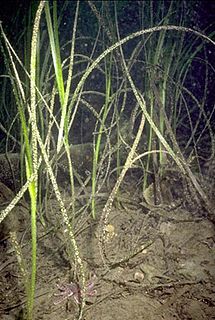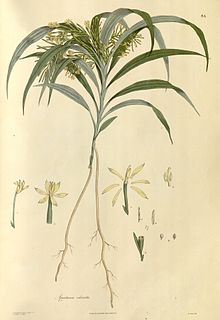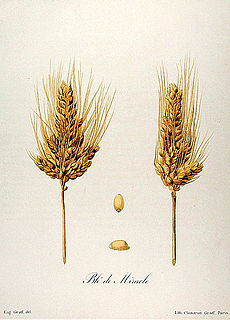
Hordeum is a genus of annual and perennial plants in the grass family. They are native throughout the temperate regions of Africa, Eurasia, and the Americas.

The Indomalayan realm is one of the eight biogeographic realms. It extends across most of South and Southeast Asia and into the southern parts of East Asia.

Stipa is a genus of around 300 large perennial hermaphroditic grasses collectively known as feather grass, needle grass, and spear grass. They are placed in the subfamily Pooideae and the tribe Stipeae, which also contains many species formerly assigned to Stipa, which have since been reclassified into new genera.

Zostera is a small genus of widely distributed seagrasses, commonly called marine eelgrass, or simply seagrass or eelgrass, and also known as seaweed by some fishermen and recreational boaters including yachtsmen. The genus Zostera contains 15 species.

Aegilops is a genus of Eurasian and North American plants in the grass family, Poaceae. They are known generally as goatgrasses. Some species are known as invasive weeds in parts of North America.

Apostasia, commonly known as grass orchids, is a genus of eight species of primitive orchids in the family Orchidaceae. They are terrestrial, evergreen, grass-like plants, barely recognisable as orchids and are distributed in humid areas of the Himalayan region, China, India, Sri Lanka, Southeast Asia, New Guinea, and Queensland. They have many narrow leaves and small yellow or white, non-resupinate, star-like flowers usually arranged on a branched flowering stem.

During 10,000 years of cultivation, numerous forms of wheat, many of them hybrids, have developed under a combination of artificial and natural selection. This diversity has led to much confusion in the naming of wheats. This article explains how genetic and morphological characteristics of wheat influence its classification, and gives the most common botanical names of wheat in current use. Information on the cultivation and uses of wheat is at the main wheat page.

Libertia is a genus of monocotyledonous plants in the family Iridaceae, first described as a genus in 1824. It is native to South America, Australia, New Guinea, and New Zealand. Eight species are endemic to New Zealand.

Triticeae is a botanical tribe within the subfamily Pooideae of grasses that includes genera with many domesticated species. Major crop genera found in this tribe include wheat, barley, and rye; crops in other genera include some for human consumption, and others used for animal feed or rangeland protection. Among the world's cultivated species, this tribe has some of the most complex genetic histories. An example is bread wheat, which contains the genomes of three species with only one being a wheat Triticum species. Seed storage proteins in the Triticeae are implicated in various food allergies and intolerances.

Achnatherum is a genus of plants which includes several species of needlegrass. Several needlegrass species have been switched between Achnatherum and genus Stipa; taxonomy between the two closely related genera is still uncertain.

Elymus is a genus of perennial plants with approximately 150 species in the grass family, related to rye, wheat, and other widely grown cereal grains.

Haplomitriopsida is a newly recognized class of liverworts comprising fifteen species in three genera. Recent cladistic analyses of nuclear, mitochondrial, and plastid gene sequences place this monophyletic group as the basal sister group to all other liverworts. The group thus provides a unique insight into the early evolution of liverworts in particular and of land plants in general.

Elymus hystrix, known as eastern bottlebrush grass, or bottle-brush-grass, is a bunchgrass in the grass family, Poaceae. It is native to the Eastern United States and Eastern Canada.

Chionochloa is a genus of tussock grass in the family Poaceae, found primarily in New Zealand with one known species in New Guinea and another on Lord Howe Island. Some of the species are referred to as snowgrass.

Pseudoroegneria spicata is a species of grass known by the common name bluebunch wheatgrass. This native western North American perennial bunchgrass is also known by the scientific synonyms Elymus spicatus and Agropyron spicatum. The grass can be found in the United States, Canada, and Mexico from Alaska and Yukon south as far as Sonora and Nuevo León.
Hystrix was a formerly recognized genus of grass.

Anthosachne sacandros is a species of true grass in the tribe Triticeae. It is endemic to the Richmond temperate forests of the Marlborough Region, New Zealand. It is a medium-size, tufted, perennial grass that is primarily coastal, but extends inland in some locations. It grows on limestone cliffs, bluffs and river terraces, from elevations of 0–900 m. It flowers from October–February, and fruits from December–May. It is distinguished from the related A. falcis by its erect growth form, long, thin, ribbed and glaucous leaf blades, and the dense hairs at the leaf blade–ligule junction. It is threatened by introduced species such as the common brushtail possum, and plants such as Lycium ferocissimum and Pinus contorta. Its isolated populations are also threatened by fire, floods and erosion.
Stenostachys is a genus of plants in the grass family, found only in New Zealand. It is sometimes included in the genus Elymus.

Epichloë festucae is a systemic and seed-transmissible endophytic fungus of cool season grasses.

Kesara Margrét Anamthawat-Jónsson is professor of botany and plant genetics at the Faculty of Life and Environmental Sciences, School of Engineering and Natural Sciences, University of Iceland.


















